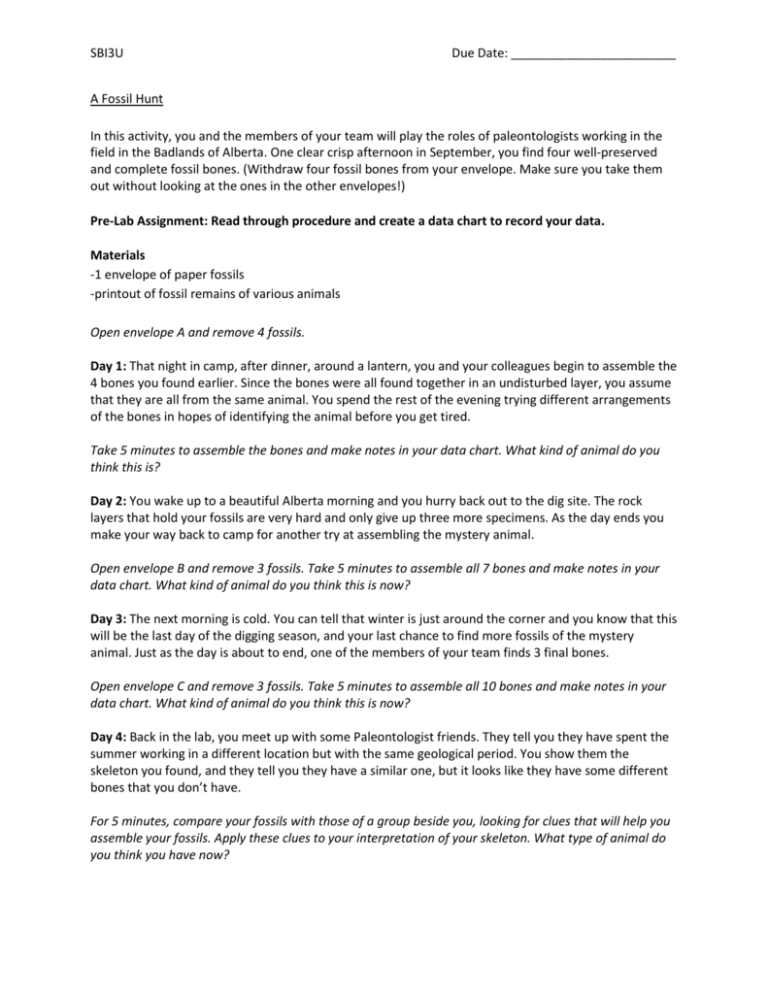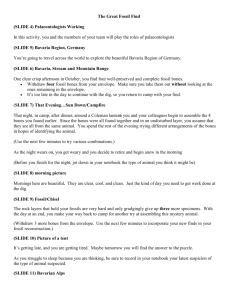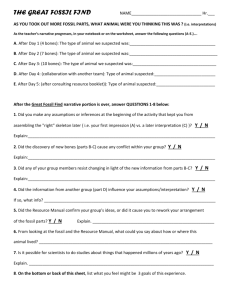dry lab - Biology11section2
advertisement

SBI3U Due Date: ________________________ A Fossil Hunt In this activity, you and the members of your team will play the roles of paleontologists working in the field in the Badlands of Alberta. One clear crisp afternoon in September, you find four well-preserved and complete fossil bones. (Withdraw four fossil bones from your envelope. Make sure you take them out without looking at the ones in the other envelopes!) Pre-Lab Assignment: Read through procedure and create a data chart to record your data. Materials -1 envelope of paper fossils -printout of fossil remains of various animals Open envelope A and remove 4 fossils. Day 1: That night in camp, after dinner, around a lantern, you and your colleagues begin to assemble the 4 bones you found earlier. Since the bones were all found together in an undisturbed layer, you assume that they are all from the same animal. You spend the rest of the evening trying different arrangements of the bones in hopes of identifying the animal before you get tired. Take 5 minutes to assemble the bones and make notes in your data chart. What kind of animal do you think this is? Day 2: You wake up to a beautiful Alberta morning and you hurry back out to the dig site. The rock layers that hold your fossils are very hard and only give up three more specimens. As the day ends you make your way back to camp for another try at assembling the mystery animal. Open envelope B and remove 3 fossils. Take 5 minutes to assemble all 7 bones and make notes in your data chart. What kind of animal do you think this is now? Day 3: The next morning is cold. You can tell that winter is just around the corner and you know that this will be the last day of the digging season, and your last chance to find more fossils of the mystery animal. Just as the day is about to end, one of the members of your team finds 3 final bones. Open envelope C and remove 3 fossils. Take 5 minutes to assemble all 10 bones and make notes in your data chart. What kind of animal do you think this is now? Day 4: Back in the lab, you meet up with some Paleontologist friends. They tell you they have spent the summer working in a different location but with the same geological period. You show them the skeleton you found, and they tell you they have a similar one, but it looks like they have some different bones that you don’t have. For 5 minutes, compare your fossils with those of a group beside you, looking for clues that will help you assemble your fossils. Apply these clues to your interpretation of your skeleton. What type of animal do you think you have now? SBI3U Due Date: ________________________ Day 5: In the library at school you find a Skeletal Resource Manual with drawings of the skeletons of some existing animals. You notice some interesting similarities between some of the drawings and your unknown fossil. Use the drawings to assist you in your final assembly of the fossil skeleton. Fill in the data table with your final interpretation of the skeleton. When you are finished, pick up the poster instructions at the front and start working on your poster with your partner. Discussion Questions: 1. Did your group reach an agreement on the identity of the animal? Explain why or why not. 2. Did the discovery of new bones cause any conflict within your group? Why or why not? 3. From looking at the fossil and the manual what could you say about how and where the animal lived? 4. What features of the nature of science do you think this activity demonstrates? SBI3U Due Date: ________________________ Teacher Notes: Ministry Expectations: Big Ideas: The Theory of Evolution is a scientific explanation based on a large accumulation of evidence Overall Expectations: A1. Demonstrate scientific investigation skills in the four areas of skills (initiating and planning, performing and recording, analyzing and interpreting, and communicating) C2. Investigate evolutionary processes, and analyze scientific evidence that supports the theory of evolution. Specific Expectations: A1.1 formulate relevant scientific questions about observed relationships, ideas, problems, or issues, make informed predictions, and/or formulate educated hypotheses to focus inquires or research. Lesson adapted from http://www.indiana.edu/~ensiweb/lessons/gff.pdf.html Fossils are important to the study of evolution. The fossil record provides the basis of specification and extinction. In this activity students are taken on an imaginary fossil hunt. Students "find" (remove from envelope) paper "fossils" of some unknown creature, only a few at a time. Students work collaboratively to try and identify the animal from the paper fossil bones. All the fossil bones in each envelope are the same animal. This lab shows that science is uncertain; as new evidence is revealed, ideas may change. Also the activity provides lessons in the Nature of Science and hypothesizing and refining hypothesis. It is apparent how the hypothesized animal changes depending on how many fossilized bones that students have pulled. First, you will need to get printouts of the pdf files at the end of this lesson. Make enough copies of the "fossils" sheets so you will have at least one sheet per team in a period, plus a few extras in case of loss. For a class of 24, you should have a minimum of 18 envelopes- 6 each of A, B and C. Cut apart the bones on the fossil sheet so that there are 3 bones in envelope A and C and 4 bones in B. When distributing bones, ensure that there aren’t the same bones in A, B or C envelope and ensure that not all A’s, B’s or C’s have the same bones. Since there are more than 11 bones in the paper fossil this should be very possible. This will allow different groups to compare their results as mentioned on Day 4. Each group should be distributed the envelopes as per the storyline. Ensure that students do the pre-lab by giving the assignment to them the day before and check for their data chart. Suggested data chart for students Day Number of Total Hypothesis Notes SBI3U Due Date: ________________________ Bones 1 2 3 3 4 3 Number of Bones 3 7 11 The dry lab is greatly improved if the instructions are read aloud. I think it would be great for dramatic flair. Also, it will keep students in time. Finally reading the parts aloud will also allow for ELL learners or students with learning disabilities to be able to follow easily. The activity is limited since it takes a lot of time to set up the envelopes and prepare. However the activity is cheap and accessible to teachers in all schools. The fact that paper is used is also a limitation; it is not malleable and cannot be treated like a fossil. In an ideal world it would be terrific to use casts of fossils, however these are expensive. This activity can be expanded by repeating with another fossil, see attached fossil for prehistoric whale, Pakicetus. This fossil is incomplete fossil attached which can also be used to show students a more realistic version of paleontology. Another limitation to this activity is that it is very student driven which means that the activity must be scaffolded. Teacher should keep students on task and topics but not give too much information. After the lab is completed ensure that all the envelopes with bones and Skeletal Resource Manuals are returned as these class sets can be reused. Make sure that students finish up discussion questions. Then ask groups to share the creature that they thought it was and discuss their answers to the questions at this time. Is there general consensus on what the creature was? If there was NO consensus, discuss what solution seems "best", and why it seems best; what criteria are being used? What factors are influencing this decision? Do NOT tell your students the fossils identity! They will clamor to know, but you have to tell them that science is NOT in the business of KNOWING; just coming as close as we can to the MOST LIKELY solution is the best we can do. Tell them this is what really happens in science. We often don't have all the pieces, and may never ever find them, so we simply rely on our "best" interpretation based on the clues we do have. Assessment of the lab is designed as an Assessment of learning. There is no formal assessment piece, but as the activity is preformed and answers are taken up in class attention should be paid to students understanding. Some possible answers to the discussion questions: Discussion Questions: 1. Did your group reach an agreement on the identity of the animal? Explain why or why not. Depends on the group and which bones are given. Since the groups share their bones on Day 5 some students will be able to come up with an animal. However since animal given is extinct this activity may prove difficult for some. 2. Did the discovery of new bones cause any conflict within your group? Why or why not? SBI3U Due Date: ________________________ It is expected that new bones caused some conflict as the initial arrangement needs to be revised to fit the new bones. 3. From looking at the fossil and the manual what could you say about how and where the animal lived? The expected answer is that the animal is a land animal with the ability to fly. 4. What features of the nature of science do you think this activity demonstrates? This lab demonstrates the uncertainity of science. Also that scientific findings are determined by collaboration. Suggested cutting for fossil S. Crassirostsis.






